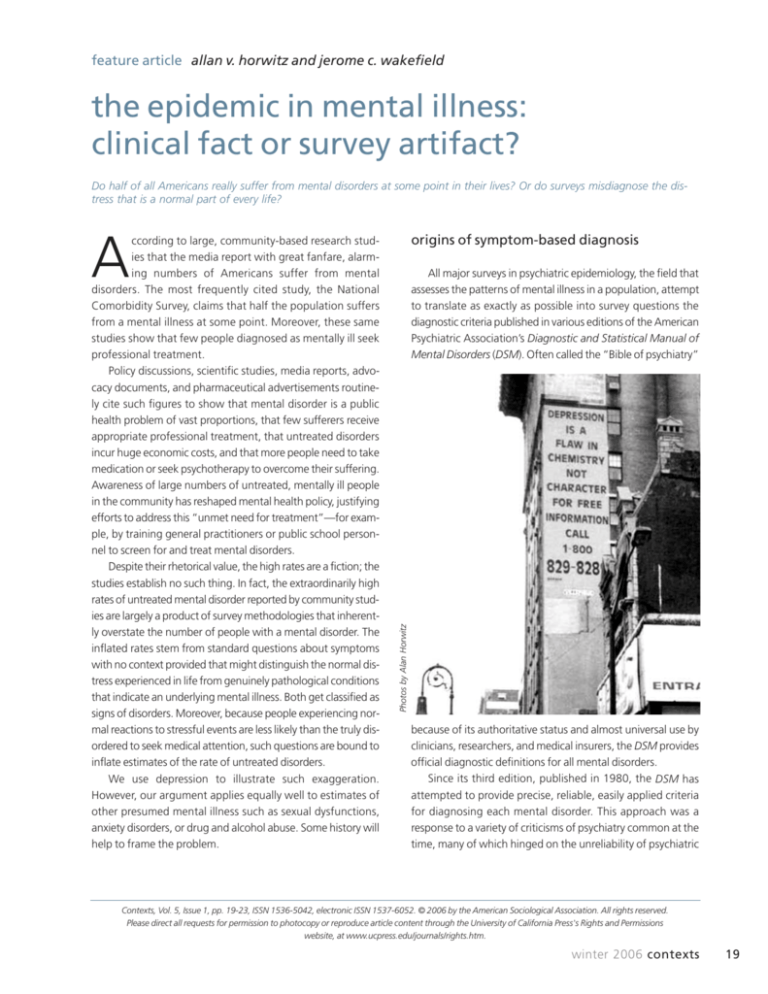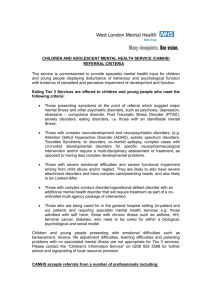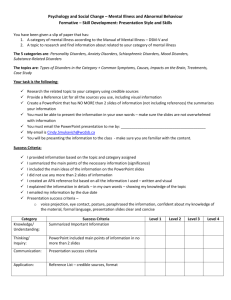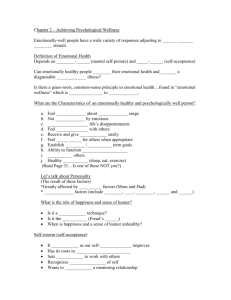
feature article allan v. horwitz and jerome c. wakefield
the epidemic in mental illness:
clinical fact or survey artifact?
Do half of all Americans really suffer from mental disorders at some point in their lives? Or do surveys misdiagnose the distress that is a normal part of every life?
A
origins of symptom-based diagnosis
All major surveys in psychiatric epidemiology, the field that
assesses the patterns of mental illness in a population, attempt
to translate as exactly as possible into survey questions the
diagnostic criteria published in various editions of the American
Psychiatric Association’s Diagnostic and Statistical Manual of
Mental Disorders (DSM). Often called the “Bible of psychiatry”
Photos by Alan Horwitz
ccording to large, community-based research studies that the media report with great fanfare, alarming numbers of Americans suffer from mental
disorders. The most frequently cited study, the National
Comorbidity Survey, claims that half the population suffers
from a mental illness at some point. Moreover, these same
studies show that few people diagnosed as mentally ill seek
professional treatment.
Policy discussions, scientific studies, media reports, advocacy documents, and pharmaceutical advertisements routinely cite such figures to show that mental disorder is a public
health problem of vast proportions, that few sufferers receive
appropriate professional treatment, that untreated disorders
incur huge economic costs, and that more people need to take
medication or seek psychotherapy to overcome their suffering.
Awareness of large numbers of untreated, mentally ill people
in the community has reshaped mental health policy, justifying
efforts to address this “unmet need for treatment”—for example, by training general practitioners or public school personnel to screen for and treat mental disorders.
Despite their rhetorical value, the high rates are a fiction; the
studies establish no such thing. In fact, the extraordinarily high
rates of untreated mental disorder reported by community studies are largely a product of survey methodologies that inherently overstate the number of people with a mental disorder. The
inflated rates stem from standard questions about symptoms
with no context provided that might distinguish the normal distress experienced in life from genuinely pathological conditions
that indicate an underlying mental illness. Both get classified as
signs of disorders. Moreover, because people experiencing normal reactions to stressful events are less likely than the truly disordered to seek medical attention, such questions are bound to
inflate estimates of the rate of untreated disorders.
We use depression to illustrate such exaggeration.
However, our argument applies equally well to estimates of
other presumed mental illness such as sexual dysfunctions,
anxiety disorders, or drug and alcohol abuse. Some history will
help to frame the problem.
because of its authoritative status and almost universal use by
clinicians, researchers, and medical insurers, the DSM provides
official diagnostic definitions for all mental disorders.
Since its third edition, published in 1980, the DSM has
attempted to provide precise, reliable, easily applied criteria
for diagnosing each mental disorder. This approach was a
response to a variety of criticisms of psychiatry common at the
time, many of which hinged on the unreliability of psychiatric
Contexts, Vol. 5, Issue 1, pp. 19-23, ISSN 1536-5042, electronic ISSN 1537-6052. © 2006 by the American Sociological Association. All rights reserved.
Please direct all requests for permission to photocopy or reproduce article content through the University of California Press's Rights and Permissions
website, at www.ucpress.edu/journals/rights.htm.
winter 2006 contexts
19
diagnosis. That is, different clinicians were likely to diagnose
approach to diagnosis. Because researchers generally acceptthe same individual in different ways. Two problems led to this
ed the DSM criteria as authoritative, psychiatric epidemioloembarrassing result. First, members of different theoretical
gists could use them without having to do elaborate studies
schools often conceived of and defined
disorders differently, on the basis of their
own theoretical concepts, whether psychodynamic, biological, or behavioral.
Second, earlier definitions were generally vague and referred to fuzzily defined
internal processes. To increase reliability,
the third edition of the DSM (DSM-III)
addressed both problems by stating
diagnostic criteria strictly in terms of
observable or reportable symptoms.
Theoretical concepts were left out of
diagnosis, which became “theory neutral.” The new definitions used only
symptoms that clinicians could precisely
describe and reliably ascertain.
The DSM-III approach of defining disorders by presenting lists of symptoms is
still used in the current edition published
in 2000. For example, the definition of
depressive disorder requires that five of
Examples of screening questions for depression from the National Comorbidity
Study
the following nine symptoms be present
during a two-week period: depressed
of their own to establish their validity. Moreover, the
mood, lack of pleasure or interest in usual activities, change in
approach seemed to resolve a series of problems that plagued
appetite or weight, insomnia or excessive sleep, psychomotor
agitation or retardation (slowing down), fatigue or loss of enercontemporary community studies of mental disorder.
gy, feeling worthless or inappropriately guilty, lack of concenEarly studies in psychiatric epidemiology had simply surveyed various treatment settings and relied on the diagnoses
tration or indecisiveness, and recurrent thoughts of death,
contained in medical charts to determine rates of mental dissuicide, or a suicide attempt. Cases of normal bereavement
order. But it soon became apparent that the number of treatafter the death of a loved one are exempted from diagnosis, but
ed patients did not reliably indicate the degree of mental
only if the grief involves no severe symptoms and lasts no more
disorder in a community for a variety of reasons, such as lack
than two months.
of access to appropriate treatment, people’s reluctance to seek
using standardized questions in community
professional help because of stigma or cost, and variations in
surveys
diagnostic practices. Community studies of mental disorders
try to get around these problems by attempting to determine
Epidemiologists study rates and patterns of disease in
directly how many people in the community have various
order to find clues about causes and determine possible treatmental disorders, regardless of whether they have undergone
ments. They eagerly embraced the DSM’s symptom-based
treatment. This requires interviewing many “normal” as well
as disordered people.
In contrast to respondents in treatment studies, most of
For the past thirty years, Allan V. Horwitz has studied various social
the people in community studies have never been diagnosed
aspects of mental disorders and normality. Jerome Wakefield was
with mental disorders. Thus, to establish rates of disorders in
trained in philosophy and clinical social work, and writes on the
the overall population, community surveys must collect thouconceptual foundations of the mental health professions. They are
sands of cases. This poses formidable challenges. For one
now collaborating on a book, The Loss of Sadness, which deals with
thing, psychiatric or other professional interviewers are expenthe transformation of sadness into Major Depression.
sive. For another, unless questions are carefully standardized,
20
contexts winter 2006
there is the danger of unreliability in the way the interviews are
conducted. Additionally, valid analysis of qualitative data such
as psychiatric interviews is extremely difficult.
The DSM’s symptom-based diagnostic criteria offered a solution to these problems. Epidemiologists conducting community
studies simply translated the DSM’s symptoms into closed-format questions about symptoms experienced by respondents.
This yielded a questionnaire that nonprofessionals could be
trained to administer, allowing cost-effective collection of data
from large numbers of people. Computer programs using the
DSM criteria could determine if a disorder was present.
Accurate estimates of prevalence require that different
interviewers ask these questions in exactly the same way. As
one study notes, “The interviewer reads specific questions
and follows positive responses with additional prescribed
questions. Each step in the sequence of identifying a psychiatric symptom is fully specified and does not depend upon
the judgment of the interviewers.” Without such standardization, even minor variations in wording or in the interviewer’s probes or instructions can lead to different results. The
resulting standardized interview format excluded any discussion of the reported symptoms and their context. The rigid
approach of structured interviews improves the consistency
of symptom assessment across interviewers and research sites
and thus the reliability of diagnostic decisions. Note, however, that the decision to use decontextualized, symptom-based
measures in community studies assumes an uncritical acceptance of the DSM’s symptom-based criteria and is based largely on considerations of practicality and cost, not on
independent tests that prove the accuracy of such methods
in identifying disorders in the community.
are survey-based diagnoses equivalent to
clinical diagnoses?
The diagnoses of particular disorders in surveys, however
reliable they may be, provide poor measures of mental illness
in community populations. The core assumption in community studies is that tightly structured questions allow researchers
to obtain diagnoses that are comparable to those of a psychiatrist, since the questions match the DSM’s symptom criteria.
This assumption rests in turn on the assumption that those criteria are valid for identifying disorders. However, those diagnosed as having mental disorders in community populations
differ in two fundamental ways from those who seek mental
health treatment.
First, people seeking help are highly self-selected and use
all sorts of contextual information to decide for themselves if
their feelings exceed ordinary and temporary responses to
stressful events. David Karp, for example, found that
depressed people sought help from psychiatrists only after
they attributed their symptoms to internal psychological problems and not to stressful situations:
[O]nce it becomes undeniable that something is really
wrong, that one’s difficulties are too extreme to be
pushed aside as either temporary or reasonable, efforts
begin in earnest to solve the problem. Now choices to
relieve pain are made with a conscious and urgent deliberation. The shift in thinking often occurs when the presumed cause of pain is removed, but the difficulty
persists. Tenure is received, you finally get out of an
oppressive home environment, a destructive relationship
is finally ended, and so on, but the depression persists.
Such events destroy theories about the immediate situational sources of depression and force the unwelcome
interpretation that the problem might be permanent and
have an internal locus. One has to consider that it might
be a problem of the self rather than the situation.
People who enter treatment thus have already decided that their
problems go beyond normal reactions.
Second, clinicians as well as patients make contextual
judgments of symptoms when they diagnose mental illness in
treated populations. Psychiatrists have long recognized that
symptoms such as depressed mood, loss of interest in usual
activities, insomnia, loss of appetite, inability to concentrate,
and so on might naturally occur in response to major losses,
humiliations, or threats to one’s meaning system, such as having a marriage unravel, losing one’s job or pension, or failing
a test that has serious implications for one’s career.
Such reactions, even when quite intense, are part of normal human nature. Applying the DSM’s symptom-based criteria literally, with no professional judgment, would result in
classifying such normal reactions as disordered. Clinical diagnosis has a built-in backup system for catching such potential
misdiagnoses: the clinician takes a psychiatric history in an
interview that includes questions about context. The clinician
is free to deviate from the literal DSM criteria in arriving at a
diagnostic judgment and is responsible for doing so when the
criteria erroneously classify a normal reaction as disordered.
How often clinicians actually use this corrective option is
unknown, but at least it exists in principle.
Thus, in treated populations, contextual judgments by
both patients and clinicians precede clinical diagnosis. In contrast, the diagnostic process in community studies, which
involve neither self-evaluation by respondents nor clinical
judgment, ignores the context in which symptoms develop.
Survey interviewers are forbidden to judge the validity of
responses or to discuss the intent of questions, and they neither exercise clinical discretion nor use flexible probes about
responses. Even if the respondent seems to misunderstand a
winter 2006 contexts
21
current (30-day) episode of major depression, about 10 percent
had this condition in the past year, about 17 percent at some
point in their lives, and about 24 percent report enough symptoms for a lifetime diagnosis of either depression or dysthymia, a
related disorder. It also finds that relatively few people diagnosed
with these conditions have sought professional help: only about
a third of those with survey-identified Major Depressive Disorders
had sought professional treatment, and far fewer sought any
kind of help from mental health professionals.
Are the many cases of Major Depressive Disorder uncovered in such community studies equivalent to treated clinical
cases? In contrast to clinical settings, where the judgments of
both lay persons and clinicians distinguish ordinary sadness
from depressive disorders, symptom-based diagnoses in comthe prevalence of depression
munity studies consider everyone who reports enough symptoms as having the mental disorder of depression. A
The most widely cited estimates of the prevalence of
respondent might recall symptoms such as depressed mood or
depression in the United States in the scientific, policy, and
insomnia that lasted longer than two weeks after the breakup
popular literatures stem from the National Comorbidity Survey
of a romantic relationship, during a
(NCS) conducted in the early 1990s,
with a ten-year follow-up, and from a
Community studies, rather loved one’s serious illness, or the
unexpected loss of a job. Although
similar study, the Epidemiologic
than uncovering high rates
these symptoms might have dissipatCatchment Area (ECA) study underof
depressive
disorders,
ed as soon as a new relationship
taken in the early 1980s. The NCS
simply show that the natural developed, the loved one recovered,
uses two steps to obtain diagnoses of
or another job was found, this person
depression based on DSM criteria.
results of acute or chronic
would be counted among the many
First, respondents must answer yes to
stressful experiences could
millions who suffer from the preat least one of the following stem
be distressing enough to fit
sumed disorder of depression each
questions at the beginning of the
the DSM definition of a
year. For example, in the ECA study
interview: (1) “In your lifetime, have
disorder.
the most commonly reported sympyou ever had two weeks or more
toms are “trouble falling asleep, staywhen nearly every day you felt sad,
ing asleep, or waking up early” (33.7 percent); being “tired out
blue, or depressed?”; (2) “Have you ever had two weeks or
all the time” (22.8 percent); and “thought a lot about death”
more when nearly every day you felt down in the dumps, low,
ever
been
two
weeks
or
more
(22.6 percent). College students during exam periods, people
or gloomy?”; (3) “Have there
who must work overtime, who are worried about an imporwhen you lost interest in most things like work, hobbies, or
tant upcoming event, or who take the survey soon after the
things you usually liked to do?” and (4) “Have you ever had
death of a famous person would all naturally experience such
two weeks or more during which you felt sad, blue, depressed
symptoms.
or where you lost all interest and pleasure in things that you
Symptoms that neither respondents nor clinicians would
usually cared about or enjoyed?” Since these questions are so
see as requiring treatment may nevertheless qualify as signs of
broad and do not allow for reference to the circumstances in
disorder in community surveys. Moreover, the duration critewhich the moods arose, it is no surprise that 56 percent of the
ria only require that the symptom last for a two-week period,
population replies yes to at least one of them. Later in the
so that many transient and self-correcting symptoms are
interview, respondents are asked questions about symptoms
derived from the DSM criteria for Major Depressive Disorder.
counted as disordered. In other cases, reported symptoms
could be normal responses to long-standing conditions of
To be diagnosed with depression, community members must
poverty, oppression, or injustice. Diagnostically oriented comreport having depressed mood or inability to feel pleasure
munity studies, rather than uncovering high rates of depresalong with four additional symptoms, such as loss of appetite,
sive disorders, simply show that the natural results of acute or
difficulty sleeping, fatigue, or inability to concentrate on ordinary activities.
chronic stressful experiences could be distressing enough to
The NCS estimates that about 5 percent of subjects have a
fit the DSM definition of a disorder.
question, the interviewer is instructed to repeat the question
verbatim. The absence of interviewer probes can produce
seriously misleading results. For example, when asked, “Have
you ever had a period of two weeks or more when you had
trouble sleeping,” a person might recall a time when ongoing construction across the street interrupted her sleep. In
such a case, she can disregard the literal meaning of the question, self-censor her response, and not report the “symptom.” Or she can give an answer that is literally true, with the
result that her troubled sleep will be counted as a potential
symptom of a mental illness. The lack of clinical judgment
based on exploring context can easily inflate reported rates
of pathological conditions.
22
contexts winter 2006
why are the high rates perpetuated?
The exaggerated rates of mental disorder in community
surveys do not mean that untreated psychiatric disorders are
not a significant problem. Nor do they mean that people who
experience normal distress may not sometimes benefit from
drugs or psychological treatments. It does, however, contribute to a pervasive medicalization of many problems that
we might view more constructively as expectable results of
social circumstances.
Community surveys could more adequately separate ”normal” responses to stressful situations from mental disorders
by including questions about the context in which symptoms
develop and persist. Interviewers could ask, for example, if
symptoms of depression emerged during periods of intense
stress and disappeared as soon as these crises were over.
Clinical interviews often include such probes, which are also
compatible with basic principles of survey methodology; psychiatrists have always recognized the need for such considerations. The decision not to include contextual criteria in
community surveys may involve not only the efficiency and
practicality of decontextualized, standardized methods but
also resistance to change by groups that benefit from the
reported high rates of mental illnesses.
During the 1960s the National Institute of Mental Health
(NIMH) promoted an expansive agenda of community mental health and sponsored projects that attempted to alleviate
poverty, combat juvenile delinquency, and promote social
change, but political changes in the 1970s forced the NIMH
to change its focus from social and economic problems to
specific diseases. This was more politically palatable than
addressing controversial social problems. In addition, the rise
of the biological paradigm in psychiatry naturally shifted
emphasis from the social circumstances that can produce
mental illness toward internal sources. The NIMH funded the
epidemiological studies in the 1980s and 1990s in an effort
to show that presumed disease conditions were widespread
yet untreated. The resulting belief in high prevalence rates,
which became the focus of well-known and widely disseminated documents such as the Surgeon General’s Report on
Mental Health, insulated the agency from political pressures,
expanded its mandate, enhanced the importance of the
problem it addressed, and protected its budget. Political support is more likely for an agency devoted to preventing and
curing widespread disease than for one that confronts controversial social problems.
Pharmaceutical companies have also capitalized on these
survey findings, which create a broader market for their products. Their ads focus on symptoms such as sadness, loneliness,
exhaustion, and anxiety that are common among normal peo-
ple. These ads also routinely feature the alleged numbers of
people who suffer from particular mental disorders, sending
the message that potential consumers are not unique but
share their problems with millions of others. The explosive
growth in sales of antidepressants shows the effectiveness of
this appeal.
Family advocacy groups such as the National Alliance for the
Mentally Ill embrace claims about the prevalence of mental disorders, which allow them to equate the millions of people that
community surveys identify with the far smaller number of people with truly serious mental disorders. This presumably reduces
the social distance between the mentally disordered and others,
and lowers the stigma of mental illness, potentially aiding efforts
to obtain more funding for treatment.
These groups promote high prevalence rates in the belief
that if they can convince politicians that mental illnesses are
widespread, they can gain more funding for mental health
services. But their efforts to get more treatment for currently
untreated cases are just as likely to shift resources from people who truly need professional mental health services to those
who might be distressed but are not disordered. Moreover,
such high rates may make the problem of mental illness seem
so overwhelming and potentially costly that it will not be
addressed. Erasing the distinction between “normal” and disordered conditions and calling both mental disorders may
harm the truly disabled.
recommended resources
Allan V. Horwitz. Creating Mental Illness (University of Chicago
Press, 2002). This book describes how and why the general
pathologies of psychoanalysis changed into the specific mental disorders of the DSM-III in 1980.
Lee Robins and Darrell Regier. Psychiatric Disorders in America:
The Epidemiological Catchment Area Study (The Free Press,
1991). The best compilation of conventional views regarding
psychiatric epidemiology.
U.S. Department of Health and Human Services. Mental Health:
A Report of the Surgeon General (National Institute of Mental
Health, 1999). A government report shows how epidemiological findings are used for the purposes of public policy.
Jerome K. Wakefield. “The Measurement of Mental Disorder.”
In A Handbook for the Study of Mental Health: Social
Contexts, Theories, and Systems, ed. Allan V. Horwitz and
Teresa L. Scheid (Cambridge University Press, 1999). This chapter indicates how symptom-based diagnostic categories
inflate estimates of the amount of mental disorder in epidemiological studies.
winter 2006 contexts
23








